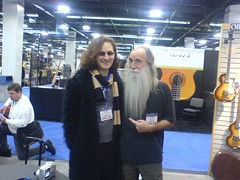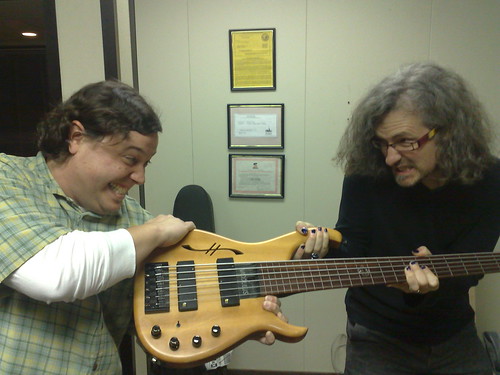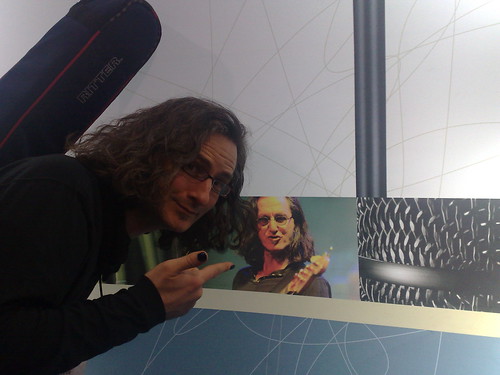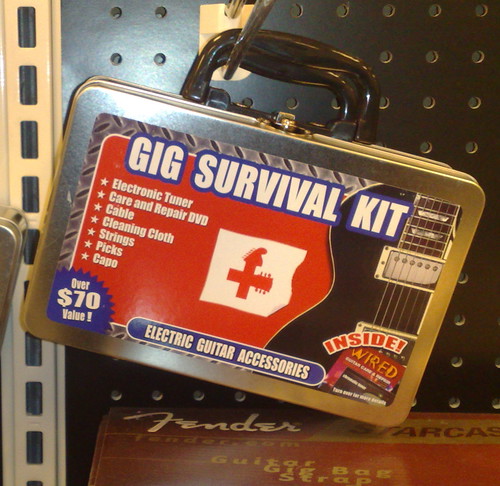 One of my favourite things about going out to NAMM each January is getting to see Lee Sklar – if you’re a bass player you obviously already know who he is. If you’re not a bassist, you might recognise Lee as the guy that played bass with James Taylor and Phil Collins who looks like the Farside version of God.
One of my favourite things about going out to NAMM each January is getting to see Lee Sklar – if you’re a bass player you obviously already know who he is. If you’re not a bassist, you might recognise Lee as the guy that played bass with James Taylor and Phil Collins who looks like the Farside version of God.
He’s a bona fide bass legend, has defined how the rest of us approach playing with singer/songwriters, but has covered so many other styles, including playing on Billy Cobham’s classic fusion record, Spectrum.
Interviewing Lee back in 99 was a real pleasure, and an honour, and since then we’ve become friends, and always catch up for a chat a NAMM. He’s on tour with Toto at the moment – if you go and see them play and get to say hi after the show, please pass on my best!
here’s the interview – enjoy!
—o0o—
Lee Sklar Interview
(Reproduced from the October 1999 issue of Bassist Magazine)
Few faces are as instantly recognisable within the bass world as Lee Sklar. The same is definitely true of his playing. With more than 30 years and 2000 albums behind him, Lee’s sound has graced more hit records than almost anyone.
Aside from being a hired gun, Lee is best known for his long standing musical relationships with Phil Collins and James Taylor. Indeed, it was the gig with James that proved to be Lee’s ticket into music full time back in the late 60s.
“I was in a lot of local bands in LA, including a band called Wulfgang,” recalls Lee. “James auditioned as the singer but wasn’t what we were looking for – we needed someone somewhere between Sam ‘n’ Dave and Robert Plant! James blew me away but just wasn’t right.
“About a year later, James asked me to do a gig, which I immediately agreed to. We did two gigs at one venue – the first was before ‘Fire and Rain’ and the place was so empty you could drive a truck through it. At the second show, the place was packed, and we knew we were onto something! So a gig which initially looked like being one or two shows ended up being 20 years.”
So was it working with James that opened the door to session work?
“Yeah. It’s funny, I’ve always considered myself a band guy. I was an art student in college and I still think I’m a better sculpture than musician. Music was just a weekend hobby – I had no intention of becoming a studio musician. I was really shocked when I started getting calls to play on people’s records.”
Unlike many bassists, it’s impossible to label the one kind of music that you get called for – your CV is so diverse. How did that come about?
“I don’t really know – I feel really fortunate to have just got the calls! I guess that once I came to the realisation that I was a studio musician, I discovered that the most essential aspect is having really wide ears, embracing all styles.”
Has that always been your approach?
“Not at all! I started playing classical piano at four years old and was still a complete classical music snob when I started studying upright bass – all orchestral stuff. I wasn’t into Elvis or the Beach Boys – I was into Gershwin and Copeland. It was a different world. Then the first time I heard the Beatles’I was an usher at the Hollywood Bowl the first time they played there – Paul changed my life! (laughs)
“When I got into the studio scene, I found myself getting all kinds of calls. One minute I’m doing Helen Reddy’s ‘I Am Woman’, and the next thing I know I’m doing ‘Spectrum’ with Billy Cobham. The calls would come in and I’d just look at everything as a challenge.
Have you ever turned down a session?
“Occasionally – I’ve had a huge amount of wrist injuries, so I can’t play thumb-popping (slap) style – I don’t have the dexterity to deal with it. So when people call me to do that, I put them in touch with friends I have – I’d rather see other guys working, and I’ll just come hang out.
“I also don’t play upright anymore. I was doing a project where I was using a Washburn 5 string fretless to get an upright sound, but they had a couple of songs where they wanted real upright and I said ‘call Patitucci’ – it was when he was still living in LA – and I went down and hung out at the sessions with John.
“I’ve always tried to understand my limitations so I try to find out ahead of time what they want on the session. The one main thing I’ve cultivated is a real sensitivity to singer/songwriters. I know how to accompany, and how to listen to a person breathe to hear where the down beat is – to never try to lead them. I’m really comfortable on that seat – I’ve never considered myself a virtuoso. It’s like going to the NAMM show and listening to all the guys with the monstrous chops – I’ve never considered myself that. I’m happy when people say I’m ‘king of the whole note’ – I really value that position as a bass player. I’ve done fusion, but I like being an accompanist.”
From a listener’s point of view, it sounds like you spot the holes, and never play across the vocal?
“I think it just requires listening and one of the problems that a lot of players have is that they don’t listen. Don’t get me wrong, I admire the tenacity that it takes to develop NAMM show chops – you see all these guys that have these different gifts and it’s fantastic. But I’m just one of these people that if I’m doing a recording and they ask for a bass solo I say I’d rather hear another song in that space, and I’ve heard some of the greatest soloists in the world play. I can enjoy it for a bit but I’m really a song person – maybe an element of it is laziness on my part. I grew up in an era where you were hired as an accompanist, even if you were doing a metal project. I really believe in the song.”
I assume that that sets producers at ease?
“Not only the producer, but I often get hired because the artist feels like they’re going to be comfortable with the extra room to breath. Guys get so used to ‘time’ that they don’t really understand that you can have a beautiful pause before a verse, because you’re human! Don’t do all your training with a metronome, try to understand what it is to really feel a song. Don’t be afraid to leave that kind of space. That’s what I’ve always liked about Asian thinking, the importance of space, allowing things not to be there.
“I did a clinic at the Bass Centre in LA a few years ago, and it scared the crap out of me. I only agreed to it as a non-playing clinic – most of the guys there were sleeping with their basses and waking up and playing them – that’s what I was like at that age, too. Anyway, they got to talking about how boring it must be to play country cos there’s not much going on. And I said a whole note is much more difficult to do than 32nd notes, which only demands proficiency. If someone gives you one note to do in a bar, there’s a whole lot more responsibility – where do you drop that note? Do you put a little vibrato on it? Which string do you play it on for tonal quality? When do you lift off? Do you mute it with your hand? They were all looking at me saying ‘geez we just thought it was boring!’
After so many tours and albums, do you still have any unfulfilled ambitions?
“I would like to get back and start sculpting again. I haven’t done it for a long time now, just because the music has occupied such a large part of my life. I’m going to be 52 years old this year, and you’d think at this point in my life that maybe things will start to slow down but I’m still as busy as ever! I’ve been working with artists from Mexico, Japan, Thailand and France; I’m musical director on a TV show, I’ve got sessions coming up with Barbra Streisand. It’s amazing to me that I’m still getting all these calls. My ambition is just to keep doing what I do. I just really enjoy getting up and going to work and playing with guys that I like playing with. That and enjoying my home life – my family, my pets, my garden, building cars. I feel like a big pie, and music is a slice of the pie but not the whole pie. It impacts everything else I do, but I don’t have to be playing every day to feel I’m a valuable person.”
In Defense Of REAL Musicians!
After 30 years in the industry, having seen recording technology blossom from the days when a four track was state of the art to what we have now – how has that changed it for players like yourself?
“Firstly, I’m all in favour of technology – I don’t want to be living in the stone age – but one of the biggest problems with technology is that it’s become so good that it’s allowed people into this business that should never have been in it. With Pro-Tools and such like, you’ve got singers that can’t sing to save their lives and engineers whose whole careers are spent tuning bad singers. You’ve got a drummer with no time, so you move the beat. As far as I’m concerned if the guy doesn’t swing, fire him – let him serve french fries in McDonald’s, but don’t let him get in a studio, because there are too many great players trying to get into that seat. That aspect of technology I find really disconcerting.
“Every once in a while I work on things and I feel like I’m in the old days. We got so used to that – going into sessions with Jim Gordon, or Jim Keltner and the pocket was so strong! Everything was based on ensemble playing, whereas nowadays, at least half the work I do, I’m just overdubbing to sequenced bass and they want it to feel natural, but you’re already handcuffed by the fact that this was done to a sequencer and they want you to make it breath a little bit and I think: why don’t they just put a rhythm section together and do this???? People are afraid – they want to keep as much control and money as they can, and are afraid to let a bunch of guys come in and actually play something. I’ve worked with people and we’ve had to make their records that way and suddenly we’ll do a gig and the first time the band plays the song it’s a hundred times better than the record and they’re wondering why! It’s because we’re all putting personality into the tunes.”
Lee’s gear
Working in such diverse situations requires quite a few different tools – here’s a list of the current Sklar arsenal [current as of Oct 99!] –
1. A Fender(ish) 4 string bass – “It has Charvel alder body, two EMG P-Bass pickups in Jazz position, but reversed, a Badass Bridge, a Hipshot D-Tuner, and mandolin fretwork.”
2 Dingwall 5-string “bitchin’!”
3 Yamaha TRB5 fretless
4 Washburn AB45(s?) acoustic fretless
5 Tubeworks DI
6 Euphonic Audio 2×8″ and 2×10″ speaker cabs.
7 Walter Woods amp
8 GK 1200 combo amp
9 Boss Octave pedal (‘my rack consists of this one pedal!’)
10 GHS Super Steel Strings 40-102.
That’s a fair amount of gear, but as the man says – “It’s still the same old me at the helm so what the hell!?”
 So, as you know, the saga so far is that British Airways smashed up my bass on the way over here back in Mid-Dec. I emailed them and rang them and was told to ‘send them the fragile tag and the bubble wrap receipt‘ – fragile tag was a generic piece of cardboard, and the request for bubble wrap receipt came off like a sick joke, if you’d seen the damage done…
So, as you know, the saga so far is that British Airways smashed up my bass on the way over here back in Mid-Dec. I emailed them and rang them and was told to ‘send them the fragile tag and the bubble wrap receipt‘ – fragile tag was a generic piece of cardboard, and the request for bubble wrap receipt came off like a sick joke, if you’d seen the damage done… But then a Joe has a light-bulb moment, remembering that there was in fact a semi-hollow Q6 body that had a tiny blemish (I couldn’t even see it!) that meant it couldn’t be sold (their quality control is exceptional). I looked at it, and loved the idea…
But then a Joe has a light-bulb moment, remembering that there was in fact a semi-hollow Q6 body that had a tiny blemish (I couldn’t even see it!) that meant it couldn’t be sold (their quality control is exceptional). I looked at it, and loved the idea…
 NAMM so far has been a whole lot of fun – have met up with loads of great friends, checked out some fab music gear, chatted a lot, drank coffee, playing some music on the looperlative booth (and discovered a couple of amazing new Looperlative features – video coming on those ASAP!)
NAMM so far has been a whole lot of fun – have met up with loads of great friends, checked out some fab music gear, chatted a lot, drank coffee, playing some music on the looperlative booth (and discovered a couple of amazing new Looperlative features – video coming on those ASAP!) One of the magical things about house concerts is just how quickly they can be put together. Because there’s no ‘press’ involved, no promotional deadlines to hit, emails can be sent out to friends as soon as the gig is decided on, and an audience can be rustled up in about 2-3 weeks.
One of the magical things about house concerts is just how quickly they can be put together. Because there’s no ‘press’ involved, no promotional deadlines to hit, emails can be sent out to friends as soon as the gig is decided on, and an audience can be rustled up in about 2-3 weeks.
 A week from today, Lo and I will be in New York! How exciting is that? Well, for us, very exciting. For you, probably less so. 🙂
A week from today, Lo and I will be in New York! How exciting is that? Well, for us, very exciting. For you, probably less so. 🙂
